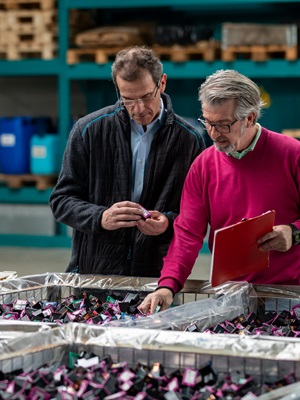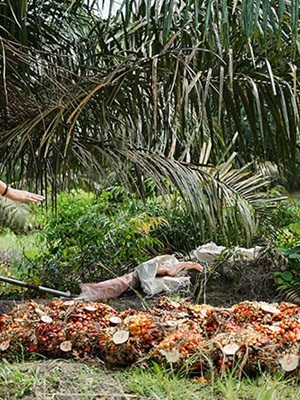Rising carbon dioxide levels not only affect global temperature, but also plant and food nutrition. An experiment run by Irakli Loladze found that increased of CO2 as photosynthetic materials was affected the plant nutrition. Adding amount of CO2 made photosyntetis more imbalance between air and soil photosyntethis materials. For example on major staple foods such as wheat and rice has reduced nutrition on plant such as vitamins, minerals and proteins. But on the other hand increase the amount of carbohydrates. This problem will create our plant lookalike junk food with high carbohydrates but less vitamin, fibre and protein (Loladze, 2014).
Over 2 billion people are already deficient in micronutrients such as iron and zinc (FAO, 2022). Rising CO2 concentrations have been shown to reduce protein and minerals in barley, potato, rice and wheat - a 10-15% reduction in protein, a 16% reduction in iron or a 9.4% reduction in zinc. Low protein, iron, zinc intake will affect to global health such as stunting, anaemia and poor immune system (Ziska, 2022). The nutritional problems are also influenced by unsustainable farming methods. Soil degradation has been spread due to use of fertiliser, irrigation and weed management which decreased soil health. Overuse of synthetic inputs can damage soil structure and threaten soil life and organic matter. Soil micro-organisms play a role in helping plants take up sufficient water and nutrients from the soil. As a result, crop density decreases and the nutritional quality of food also decreases (Montgomery & Bikle, 2022). These two factors impact on global public health will be worse with decreasing nutrients of food such as protein, iron and zinc deficiencies.
Regenerative agriculture could be the answer to rebalancing food nutrients. Regenerative agriculture is a land management philosophy in which farmers grow food in harmony with nature and their communities. Organic farming methods such as no-till, cover crops and diverse rotations encourage micro-organisms and increase soil health (Sharma, 2022). Some work has shown that organically grown crops have higher nutrient content than conventionally grown crops. A comparison of food grown in conventional and regenerative ran by Montgomery et al (2022) shows that regenerative farming had more vitamins, carotenoids, calcium, phosphorus, iron, zinc and other essential minerals rather than conventional farming. Çakmakçı (2023) also generalize from several studies that organic food have higher dry matter, sugar content, tirabtable acidity, protective substances, antioxidant potential, flavonoid, calcium, magnesium, phosphor, zinc and iron than conventionally produced crops.
A regenerative farm can reduce the amount of harmful substances in food. Organic farming avoids the use of chemical or synthetic fertilisers and pesticides. Instead, it focuses on soil health, pest control, crop rotation and the use of organic matter (Tomar, 2023). The use of synthetic fertilizers and pesticides had more residues of hazardous content such as heavy metal like cadmium, organofosfat and other pestisida residues, they also have nitrates, nitrites and other nitrogeneus subtances (Bender, 2020). These have carcinogenic and acutely lethal effects on human health. Organically grown food eliminates all potentially harmful substances. As a result, organic food has lower levels of unhealthy substances, making it safer to consume and posing no threat to human health.
Regenerative agriculture also increases resilience to climate impacts. Organic matter on the land and cover crops can improve soil health and its ability to absorb and store more water. This will protect farmland from natural disasters such as floods and droughts. This reduces the risk of loss of production or crop failure. Use of organic matter will also be carbon sequestration to absorb carbon in the atmosfer to the soil. Otherwise, eliminating use of fertilizers and synthetic pesticides release less carbon dioxide, nitrogen dioxide and methane into the atmosphere. Regenerative farming also conserves ecosystem and water and build healthy soil and abundance of biodiversity. Because of better ecosystem and healthy soil, farmers are more prepared for changing wheater or extreme wheater (Sharma, 2022). Organic approach will build resilience on farmer and rural economy.
Producing food with a sustainable approach can be a suitable solution to reduced nutrient content due to elevated CO2. It also reduces chemical pesticide and fertiliser residues on plants. With organic method, farmer can produce healthy food with more nutrients and less residues. It will save more people from significant vitamin and mineral deficiencies. It also reduces potential carcinogenic and acutely lethal effects. From an environmental perspective, regenerative agriculture can build the resilience of agricultural land and reduce carbon dioxide emissions. Agriculture as one of the sectors that emits a lot of greenhouse gases can be reduced by applying regenerative concept. Even agriculture will sequester more carbon in the atmosphere to soil if we succeed to conserve the soil and ecosystem. This method will also lead to better biodiversity and cleaner water to support the agricultural process. The positive cycle result of shifting to regenerative agriculture will bring win-win solution for food security, food nutrients, environment and increasing rural economy. Sustainable agriculture can be the suitable solution of problem appears on food nutrition and agriculture development due to rising carbon dioxide and climate change.
Literature
Bender I et al (2020) Organic carrot (Daucus carota L.) production has an advantage over conventional in quantity as well as in quality. Agronomy. 2020;10:1420. doi: 10.3390/agronomy10091420.
Çakmakçı S and Çakmakçı R (2023). Quality and Nutritional Parameters of Food in Agri-Food Production Systems. Foods. 2023 Jan; 12(2): 351. Published online 2023 Jan 11. doi: 10.3390/foods12020351
Loladze, I (2014), Hidden shift of the ionome of plants exposed to elevated CO2 depletes minerals at the base of human nutrition. Accessed on July 14th 2024
Food and Agriculture Organisation of the United Nations (2022). The state of Food Security and Nutrition in the World 2022.
Montgomery & Biklé (2022) Montgomery DR, Biklé A. What your food ate. New York: W.W. Norton; 2022.
Montgomery DR et al (2022) Soil health and nutrien density: prelimenary comparison of regenerative and conventional farming. PeerJ. 2022; 10: e12848. Published online 2022 Jan 27. doi: 10.7717/peerj.12848
Sharma, A et al (2022). Regenerative Agriculture: Farm Policy for The 21st Century. NRDC Report March 2022
Tomar SS et al (2023) Impact of Organic Farming on Human and Enviromental Health. In book: From seed to harvest (pp. 170-179). Elite Publishing House
Ziska, LH (2022) Rising Carbon Dioxide and Global Nutrition: Evidence and Action Needed. Plants (Basel). 2022 Apr; 11(7): 1000. Published online 2022 Apr 6. doi: 10.3390/plants11071000
Posted 25/07/2024



.jpg?sfvrsn=7012ca55_1)













